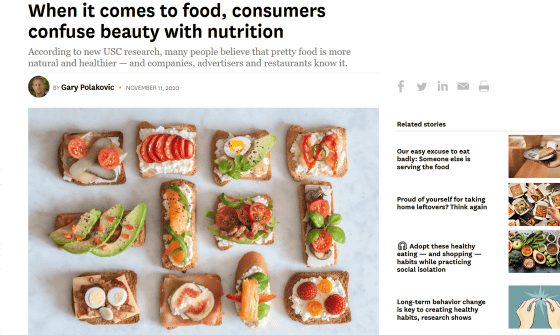It turns out that people feel that good-looking food is 'healthy'

Not only taste and aroma, but also appearance is an important factor in cooking, and restaurants will appeal to consumers by posting pictures of beautifully decorated dishes on the menu table. A total of more than 4,300 subjects were tested to examine changes in the way they look and feel, and it was shown that 'people tend to feel that good-looking food is healthy.'
Pretty Healthy Food: How and When Aesthetics Enhance Perceived Healthiness --Lina Hagen, 2020
When it comes to food, consumers confuse being pretty with being healthy
https://news.usc.edu/178179/pretty-food-natural-healthy-nutrition-advertisements-usc-research/

It seems that general consumers see about 7,000 food and restaurant advertisements a year, and about three-quarters of these advertisements are for fast food stores. Advertisers employ food stylists and image-processing teams to decorate burgers, pizzas, french fries and more to make them look attractive.
So Linda Hagen, an assistant professor of marketing at the University of Southern California 's Graduate School of Business, conducted a variety of experiments to investigate how the appearance of food changes people's perceptions.

In one experiment, 800 subjects were asked to perform the task of 'picking up pictures of'clean food'and'dirty food' by searching the Internet,' and selected pictures of ice cream, lasagna, omelets, sandwiches, etc. The subjects were asked to judge 'whether the food in the selected photo is nutritious and healthy'. As a result of this experiment, people overwhelmingly decided that 'clean food is healthier.'
In another experiment, 400 subjects were asked to 'healthy' and 'natural' photographs of 'a toast with crescent-shaped avocados lined up neatly' and 'toast with avocado chunks sloppy.' We had them evaluate by items such as 'taste'. Then, the subject judged the clean avocado toast to be 'healthier and more natural', but evaluated that both tastes were the same.
Another experiment has also shown that the 'subject's subjective sensation' of cleanliness and filth has a significant impact on the judgment of health. In this experiment, when researchers showed subjects pictures of cupcakes and spaghetti, they instilled prejudice in the subjects by stating, 'This is a picture of clean food' and 'This is a picture of dirty food.' As a result, subjects who were told by researchers that they were 'clean food' were more likely to eat the food in the photo than subjects who were told that they were 'dirty food,' even though they were actually shown the same picture. I judged it to be natural and nutritious.
In addition, as a supplementary study, Hagen also conducted a survey showing subjects 'good-looking peppers' and 'bad-looking peppers' and asking how much they would pay to purchase each. Hagen also found that 'pretty green peppers' tended to be purchased at a price that was 56% higher, and that this result was also based on the change in health that was perceived from the appearance, Hagen said. ..

'A series of experiments has repeatedly shown that people perceive foods that look beautiful are more natural and believe that their natural sensations lead to good health,' Hagen said. Pointed out that he evaluates the nutritional value and calories of food based on aesthetic sense.
Bias caused by the appearance of food fluctuates consumers' choices and willingness to buy, so too clean food advertisements can mislead consumers and make unhealthy choices. That's why Hagen said companies or regulators need to take steps, such as setting rules for food images and disclosing any work done to make them look good. ..
'People associate aesthetic beauty with natural things in their minds, which leads to the perception that'clean food is healthy food', but people look good. But in reality, you can be fooled by unhealthy foods. '

Related Posts:







